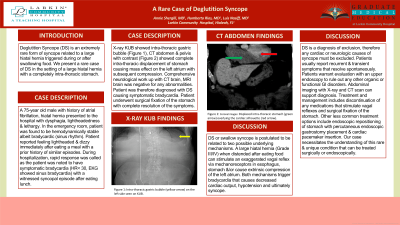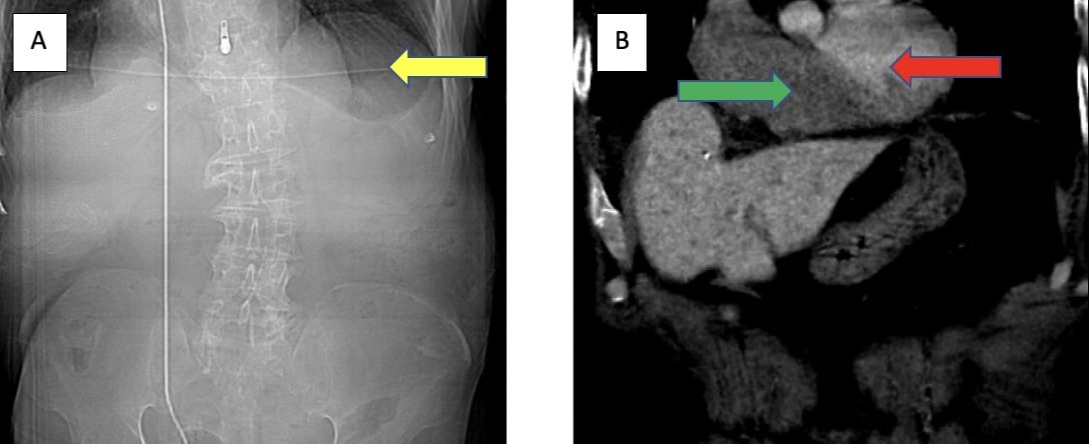Sunday Poster Session
Category: Stomach
P1385 - A Rare Case of Deglutition Syncope
Sunday, October 22, 2023
3:30 PM - 7:00 PM PT
Location: Exhibit Hall

Has Audio

Annie Shergill, MD
Larkin Community Hospital
Miami, FL
Presenting Author(s)
Annie Shergill, MD1, Humberto Rios, MD2, Luis Nasiff, MD3
1Larkin Community Hospital, Miami, FL; 2Larkin Community Hospital, Palm Springs Campus, Miami, CA; 3Larkin Community Hospital, Palm Springs Campus, Miami, FL
Introduction: Deglutition Syncope (DS) is an extremely rare form of syncope related to a large hiatal hernia triggered during or after swallowing food. We present a rare case of DS in the setting of a large hiatal hernia with a completely intra-thoracic stomach.
Case Description/Methods: A 75-year old male with history of atrial fibrillation, hiatal hernia presented to the hospital with dysphagia, lightheadedness & lethargy. In the emergency room, patient was found to be hemodynamically stable albeit bradycardic (sinus rhythm). Patient reported feeling lightheaded & dizzy immediately after eating a meal with a prior history of similar episodes. During hospitalization, rapid response was called as the patient was noted to have symptomatic bradycardia (HR< 30, EKG showed sinus bradycardia) with a witnessed syncopal episode after eating lunch. X-ray KUB showed intra-thoracic gastric bubble (Figure 1A), CT abdomen & pelvis with contrast (Figure 1B) showed complete intra-thoracic displacement of stomach causing mass effect on the left atrium with subsequent compression. Comprehensive neurological work up with CT brain, MRI brain was negative for any abnormalities. Patient was therefore diagnosed with DS causing symptomatic bradycardia. Patient underwent surgical fixation of the stomach with complete resolution of the symptoms.
Discussion: DS or swallow syncope is postulated to be related to two possible underlying mechanisms. A large hiatal hernia (Grade III/IV) when distended after eating food can stimulate an exaggerated vagal reflex via mechanoreceptors in esophagus, stomach &/or cause extrinsic compression of the left atrium. Both mechanisms trigger bradycardia that causes decreased cardiac output, hypotension and ultimately syncope. DS is a diagnosis of exclusion, therefore any cardiac or neurologic causes of syncope must be excluded. Patients usually report recurrent & transient symptoms that resolve spontaneously. Patients warrant evaluation with an upper endoscopy to rule out any other organic or functional GI disorders. Abdominal imaging with X-ray and CT scan can support diagnosis. Treatment and management includes discontinuation of any medications that stimulate vagal reflexes and surgical fixation of the stomach. Other less common treatment options include endoscopic repositioning of stomach with percutaneous endoscopic gastrostomy placement & cardiac pacemaker insertion. Our case necessitates the understanding of this rare & unique condition that can be treated surgically or endoscopically.

Disclosures:
Annie Shergill, MD1, Humberto Rios, MD2, Luis Nasiff, MD3. P1385 - A Rare Case of Deglutition Syncope, ACG 2023 Annual Scientific Meeting Abstracts. Vancouver, BC, Canada: American College of Gastroenterology.
1Larkin Community Hospital, Miami, FL; 2Larkin Community Hospital, Palm Springs Campus, Miami, CA; 3Larkin Community Hospital, Palm Springs Campus, Miami, FL
Introduction: Deglutition Syncope (DS) is an extremely rare form of syncope related to a large hiatal hernia triggered during or after swallowing food. We present a rare case of DS in the setting of a large hiatal hernia with a completely intra-thoracic stomach.
Case Description/Methods: A 75-year old male with history of atrial fibrillation, hiatal hernia presented to the hospital with dysphagia, lightheadedness & lethargy. In the emergency room, patient was found to be hemodynamically stable albeit bradycardic (sinus rhythm). Patient reported feeling lightheaded & dizzy immediately after eating a meal with a prior history of similar episodes. During hospitalization, rapid response was called as the patient was noted to have symptomatic bradycardia (HR< 30, EKG showed sinus bradycardia) with a witnessed syncopal episode after eating lunch. X-ray KUB showed intra-thoracic gastric bubble (Figure 1A), CT abdomen & pelvis with contrast (Figure 1B) showed complete intra-thoracic displacement of stomach causing mass effect on the left atrium with subsequent compression. Comprehensive neurological work up with CT brain, MRI brain was negative for any abnormalities. Patient was therefore diagnosed with DS causing symptomatic bradycardia. Patient underwent surgical fixation of the stomach with complete resolution of the symptoms.
Discussion: DS or swallow syncope is postulated to be related to two possible underlying mechanisms. A large hiatal hernia (Grade III/IV) when distended after eating food can stimulate an exaggerated vagal reflex via mechanoreceptors in esophagus, stomach &/or cause extrinsic compression of the left atrium. Both mechanisms trigger bradycardia that causes decreased cardiac output, hypotension and ultimately syncope. DS is a diagnosis of exclusion, therefore any cardiac or neurologic causes of syncope must be excluded. Patients usually report recurrent & transient symptoms that resolve spontaneously. Patients warrant evaluation with an upper endoscopy to rule out any other organic or functional GI disorders. Abdominal imaging with X-ray and CT scan can support diagnosis. Treatment and management includes discontinuation of any medications that stimulate vagal reflexes and surgical fixation of the stomach. Other less common treatment options include endoscopic repositioning of stomach with percutaneous endoscopic gastrostomy placement & cardiac pacemaker insertion. Our case necessitates the understanding of this rare & unique condition that can be treated surgically or endoscopically.

Figure: Figure 1A: Intra-thoracic gastric bubble (yellow arrow) on the left side seen on X-ray KUB; 1B: Displaced intra-thoracic stomach (green arrow) overlying the cardiac silhouette (red arrow).
Disclosures:
Annie Shergill indicated no relevant financial relationships.
Humberto Rios indicated no relevant financial relationships.
Luis Nasiff indicated no relevant financial relationships.
Annie Shergill, MD1, Humberto Rios, MD2, Luis Nasiff, MD3. P1385 - A Rare Case of Deglutition Syncope, ACG 2023 Annual Scientific Meeting Abstracts. Vancouver, BC, Canada: American College of Gastroenterology.
